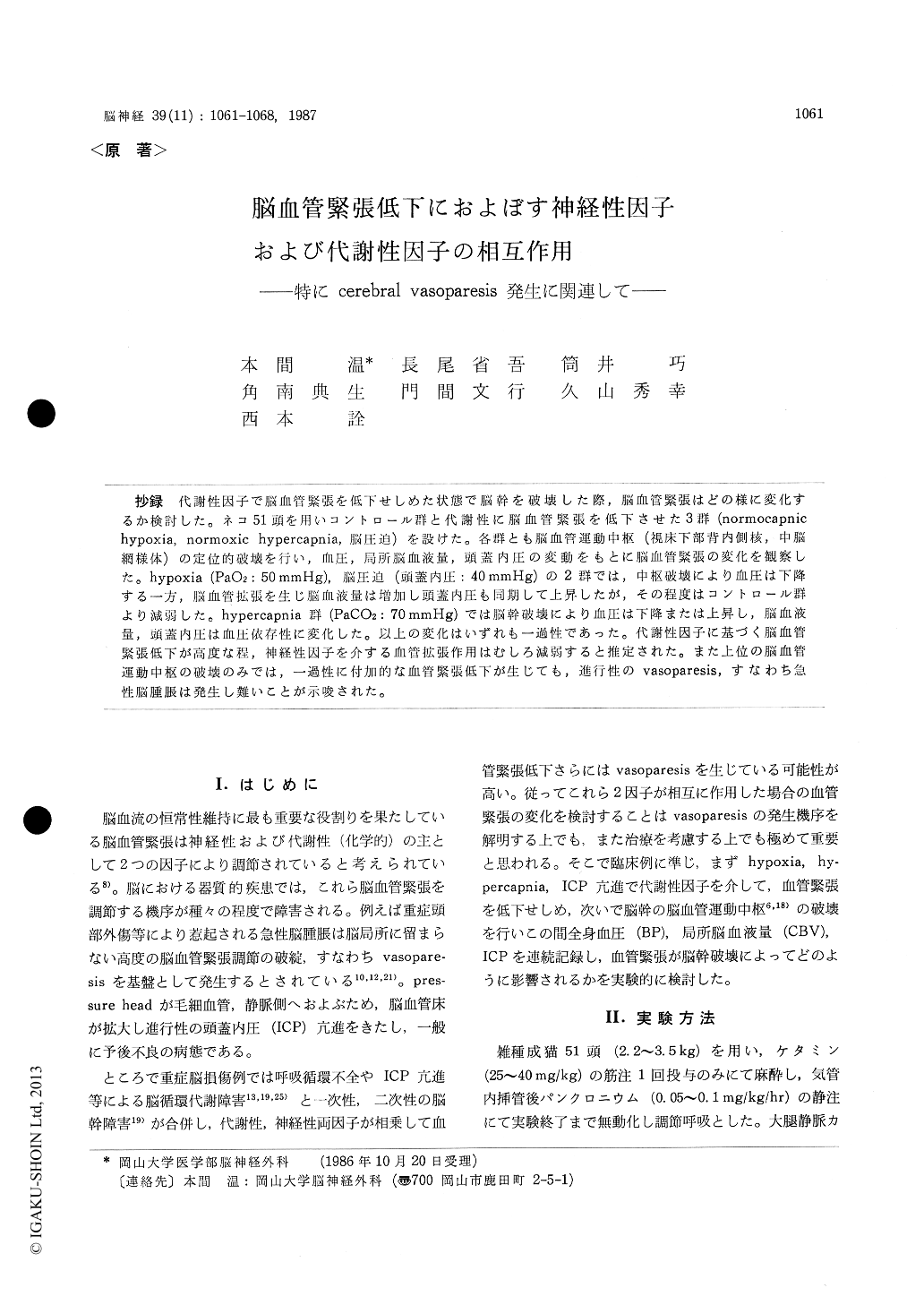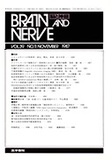Japanese
English
- 有料閲覧
- Abstract 文献概要
- 1ページ目 Look Inside
抄録 代謝性因子で脳血管緊張を低下せしめた状態で脳幹を破壊した際,脳血管緊張はどの様に変化するか検討した。ネコ51頭を用いコントロール群と代謝性に脳血管緊張を低下させた3群(normocapnichypoxia, normoxic hypercapnia,脳圧迫)を設けた。各群とも脳血管運動中枢(視床下部背内側核・中脳網様体)の定位的破壊を行い,血圧,局所脳血液量,頭蓋内圧の変動をもとに脳血管緊張の変化を観察した。hypoxia (PaO2:50 mmHg),脳圧追(頭蓋内圧:40 mmHg)の2群では,中枢破壊により血圧は下降する一方,脳血管拡張を生じ脳血液量は増加し頭蓋内圧も同期して上昇したが,その程度はコントロール群より減弱した。hypercapnia群(PaCO2:70 mmHg)では脳幹破壊により血圧は下降または上昇し,脳血液量,頭蓋内圧は血圧依存性に変化した。以上の変化はいずれも一過性であった。代謝性因子に基づく脳血管緊張低下が高度な程,神経性因子を介する血管拡張作用はむしろ減弱すると推定された。また上位の脳血管運動中枢の破壊のみでは,一過性に付加的な血管緊張低下が生じても,進行性のvasoparesis,すなわち急性脳腫脹は発生し難いことが示唆された。
It is widely accepted that a tremendous in-crease in cerebral blood volume (CBV) due to pro-gressive cerebral vasoparesis is an essential to the development of acute brain swelling. This study was designed to determine whether neurogenic and/or metabolic factors are predominant and how these interact with each other in producing cere-bral vasoaresis.
Fifty-one awake cats immobilized with pancro-nium bromide were divided into 4 groups : group I, control ; group II, noromocapnic hypoxia (PaO2= 50mmHg) ; group IQ, normoxic hypercapnia (Pa-CO2=70 mmHg), and group IV, increased intracra-nial pressure (ICP=40mmHg) by brain compression. Systemic arterial pressure (BP), CBV (photoelectric method), and ICP (epidural pressure) were conti-nuously recorded. The dorsomedial hypothalamic nucleus (DM) and the reticular formation of the midbrain (MB-RF) were bilaterally coagulated by a stereotaxic technique (3mA, 1 min). Therefore alterations in cerebrovascular tonus created by destruction of the cerebral vasomotor centers were examined in the animals with metabolically in-duced cerebral vasodilatation to various degree's.
In group I , vasomotor center destruction result-ed in an immediate and transient decrease in BP (DM ; -4.1 ± 6.7 mmHg, MB-RF ; ?10.2 ± 4.8 mmHg) and simultaneous increase in CBV and ICP (DM ; 7.6 ± 7.0 mmHg, MB-RF ; 6.0± 5.6 mmHg) for 3 to 4 minutes. Increase in ICP by destruction of vasomotor centers reduced signifi-cantly in group II (DM ; 2.3± 2.6 mmHg, MB-RF ; 1.6±1.22 mmHg) and reduced slightly in group IV (DM ; 7.5±4.0 mmHg, MB-RF ; 4.8 ± 3.2 mmHg). In these 3 groups, autoregulation of cerebral blood flow and CO2 vasoreactivity were not changed by destruction of vasomotor centers. In group HI , BP decreased (DM, MB-RF) or increased (MB-RF). Changes of CBV and ICP were parallel to those of BP. Any progressive vasoparesis was not produced in this study.
Results show that regardless of pre-existence of metabolically induced deterioration in cerebrovas-cular tonus, destruction of the cerebral vasomotor centers located in the upper brain-stem would not cause any progressive vasoparesis but transient additional vasodilatation. And also it seems that the more metabolically induced vasodilatation pre-exists, the less additional neurogenic vasodilatation due to destruction of vasomotor centers occurs. In severe hypercapnic animals, neurogenic vaso-dilatation which would alter CBV and ICP did not happen. In conclusion, not only metabolically in-duced vasodilatation but also widespread disrup-tion of cerebral vasomotor centers along the brain-stem may result in progressive cerebral vaso-paresis, namely acute brain swelling.

Copyright © 1987, Igaku-Shoin Ltd. All rights reserved.


